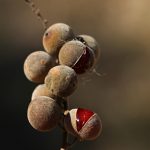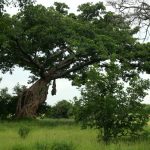TREE LIFE
APRIL 1990
MASHONALAND CALENDAR
Sunday 1st April: Rubbish collecting day at the Mukuvisi Woodlands – if you would like to help, take some plastic bags and meet at the Kiosk at 0700 hours.
Tuesday 3rd April: Botanic Garden Walk. Park your car at the Herbarium where we will meet at 1645 hours for 1700 hours.
Monday 16th April to Friday 20th April: Victoria Falls. See Tree Life no 121. There are still a few vacancies, so if you would like to join us, phone Maureen Silva Jones on 739711 before April 6th.
Saturday 28th April: Walk with Mark Hyde. Please phone Mark at home on 701023 before Friday 27th April for time and venue.
MATABELELAND CALENDAR
Sunday 1st April: To Quiet Waters Scheme of Falcon College, Esigodini, an all day outing. Bring lunch and we will try out the new field Cards, for the area produced by Ken. Meet at Ascot Car Park at 0830 hours.
Sunday 6th May: To Springs Farm, (Richard Redman) about 30km on the Maggie Wolhuter Road. A new area. Morning only. Meet at 0830 hours at Ascot Car Park.
On 25/26/27 May the Long Weekend to Shashi River/Tuli: Those interested be ready!
MATABELELAND NOTES
On Sunday 3rd March we went to Beaconsfield Farm, Bulimamangwe District – beyond Marula, the home of Derek and Barbara Viljoen. Here we investigated trees all round and ended with a total of 79 or more species. We also went 12km to the newly built Shashani Dam and even walked along the core trench cut in the rock, which we found most interesting. The velt was nice and green, sweet grass and good grazing, but there had been no run off which was disturbing. We also had a very fine lunch produced by Barbara.
Tree species we saw included 7 Acacias – A. fleckii, G. galpinii, A. garrardii, A. karroo, A. nigrescens, A. nilotica, A. rehmanniana, Allophylus africanus, A. alnifolius, some very tall Aloe excelsa, Burkea africana, Cassia abbreviata, Cassine matabelica, 5 Combretum species, C. apiculatum, C. collinum, much more frequent here than usually, C. hereroese, C. imberbe, C. molle, 5 Commiphora – C. glandulosa, (pyracanthoides), C. marlothii, C. mossambicensis, C. mollis, C. schimperi, 4 Euclea – E. divinorum, E. racamosa subsp schimperi, E. natalensis and E. undulata, Euphorbia cooperi, E. ingens, Figs –
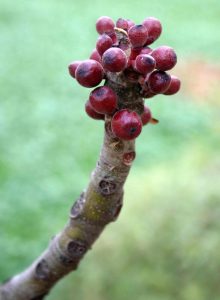
Ficus abutilifolia. Photo: Bart Wursten. Source: Flora of Zimbabwe
Ficus abutilifolia (soldanella), F. glumosa (sonderi), F. ingens, F. nigropunctata – new to us, G. thonningii (natalensis), Gardenia volkensii (spatulifolis), Grewia bicolour, G. flavescens, G. monticola, Markhamia acuminate, Mundulea sericea, Ozorea insignis subsp. reticulata, Pappea capensis, widespread, Piliostigma thoningii, Protea qaquedi, Psuedolachnostylis with leaves rounder than usual in Matabeleland – more like the Mashonaland type, Ptaeroxylon coliquum, Pterocarpus rotundifolius, widespread, Rhus lancea, R. leptodictya, R. pyroides, Sclerocarya birrea, Securidaca longipendunculata, Strychnos cucculoides, S. madagascariensis, synadenium qazense, Terminalia sericea, or Mangwe; the name tree of the District, Turraea obliquum and Ziziphus mucronata.
C. Sykes
BOTANIC GARDEN WALK : 6TH MARCH 1990
After a little discussion I am delighted to say that it was decided that we would continue with the Acacias. Tom has such a simple way of identifying them and I have tried several times to produce a simple key but have always become bogged down in a wealth of detail, so it was refreshing and very profitable to look at the subject through his eyes again. We started with a revision of first principals by looking an Acacia with straight thorns and therefore pompom flowers. This was a species with many pinnae and many leaflets. The leaf was oblong and about three times as long as it was wide. It was, of course, Acacia abyssinica, a flat topped tree occurring at higher altitudes in the east of Zimbabwe. The other species having straight thorns and leaves with many pinnae and many leaflets are Acacia rehmanniana, with rusty red brown branches and leaflets that are so small that they are almost impossible to distinguish; A. arenaria, which has very long leaves, 5 to 7 times as long as they are wide and young branches that zig zag. One would be unlikely to confuse the two in the field as A. arenaria is a shrubby species which grows in the west of the country; A. sieberiana also comes into this group, it is flat topped and occurs with A. abyssinica in the Penhalonga area. The similarity between them is a problem which has worried me for a long time, since the last time we looked at these two, in fact. Unfortunately, we did not look at it, but delving through the literature it would appear that A. sieberiana has the outer bark on the branches flaking away to reveal a yellowish under bark, the leaflets are bigger and there is usually a gland on the petiole. Only one of the books mentions a petiolar gland for A. abyssinica although they do mention glands between the pinnae. (Something which needs to be checked if any one is in the Nyanga area please). In pod, of course there is no problem; A. abyssinica has a flat pod and A. sieberiana a thick indehiscent pod.
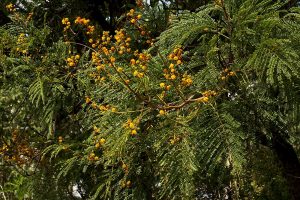
Acacia amythethophylla. Photo: Bart Wursten. Source: Flora of Zimbabwe.
Acacia amythethophylla is always conspicuous at the end of the rainy season when it comes into flower long after the other acacias. The big inflorescence at the top of the tree is a rich golden yellow, but are often infested by an insect and the flowers do not develop properly. Never the less the colour is there and perhaps curry acacia would be a more easily remembered name than large-leaved Acacia. It certainly does have the largest leaves of those in Zimbabwe, with medium to many pinnae and quite big leaflets. We then looked at an Acacia with hooked prickles. The flowers will be cylindrical. This was Acacia goetzei, which has a middle number of pinnae and a middle number of leaflets. The leaflets are quite big and there can be bosses on the trunk. It is a genuine woodland Acacia at low and medium altitudes. The small leaved form is rather similar to A. welwitschii but that is riverine, and A. burkei that only grows in the SE lowveld. The species with scattered prickles are mainly vigorous lianes with the exception of the tree like A. eriocarpa, is an escarpment species with woolly pods. A. chariessa forms part of the Acacia complex in Matabeleland and is more delicate than the others, in fact, it is necessary to move it up and down your cheek to feel the prickles. Revision over we then moved to the group with straight thorns that have fewer pinnae and fewer leaflets or, middle pinnae and middle leaflets (the G. goetzei region if we had been in the hooked prickles group). A. robusta subsp robusta is a thick solid tree with a grey bark, smooth on top and rough at the bottom, which forms part of the real Matabeleland dry Acacia complex. The leaves are borne on lateral spurs or cushions, and usually have 3 pairs of pinnae although there can be up to 5. A. robusta subsp clavigera is a more lax tree growing on riverine fringes and occasionally in jesse bush and mopane woodland. It does not have lateral spurs to the same extent and the leaves probably have 1 or 2 more pairs of pinnae and smaller leaflets. The bark is grey and there are elongated horizontal lenticels present on the branches. The pod is sickle shaped. Also with a sickle shaped pod is A. grandicornuta, a rare woodland species which grows along the south east border on the crustaceous sands. It has a leaf very like A. robusta subsp. robusta in fact they can really only be separated on floral characters and of course on distribution. Acacia karroo is very variable and grows in many different ecotypes. It has fewer leaflets than A. robusta subsp. clavigera does not have a grey bark and lacks the lenticels. It does tend to have spur shoots on which the leaves are borne. Typical A. karroo with its rusty red branches and sickle shaped bods does not really look like A. robusta subsp. clavigera at all. Acacia nilotica is going away from A. karroo and has slightly more pinnae, over five pairs and more and smaller leaflets. It often tends to be umbrella shaped with the branches forming a dense canopy and the bark is dark with long fissures looking as though it is braded. When bark splits and then joins up again it is called anastomosing. There is a gap between the pinnae whereas in the next species, A. gerrardii, they are close together and there are about the same number of pinnae but more leaflets. The leaves are borne on little cushions and are relatively small giving the impression of being tightly together along the branch like a bottle brush. The young branches are very hairy with a red under bark that can be seen showing through in small cracks. The young branches of A. karroo and A. nilotica are typically without hairs. A. gerrardii are widespread in woodland around Harare and at medium to lower altitudes. Thank you Tom, that walk clarified a lot of things for me. I am really glad that I was able to make it.
-Meg Coates Palgrave.
NYARUPINDA CATCHMENT : MARCH/APRIL 1990
My contribution to Tree Life No. 121 needs clarification on three points.
1) There is no ecotone around the quartz rise at Tinto house. The dry woodland sandy soil tree species (Monotes and Uapaca) as well as Julbernardia globiflora and Brachystegia boehmii come up the hill, some are wind pruned and others knarled.
2) In Zimbabwe soils can generally be related to the rocks which directly underlie them, the exception is alluvium.
3) A Ministry of Mines publication states that “dolerite rock is a fine to medium grained version of GABBRO and has the same mineralogy”. Samples of dolerite give a pleasing ring when struck with a hammer, i.e. metal on metal due to the presence of magnetite, iron ore.
What an exciting day, there were twice as many enthusiasts as expected. Well done! The company formed four groups which mysteriously became three when we all set off, this meant that the river environment had to be done after lunch. We managed to look at the following species near the house, Ochna gamblioides, O. schweinfurthiana, O. macrocalyx, Strychnos innocua, S. spinosa, both Uapaca kirkiana and nitida grew side by side, they are often found like this on quartz rubble slopes. Many Olax obtusifolia were there, their leaves still a fresh matt dull green, later they become afflicted by sooty moulds which are likely to grow in the honeydew secretion produced by aphids. Kim collected a sample of Vernonia glaberrima, another quartz vein species, a member of ASTERACCEAE, its arched sprays of tiny parachute fruits seen by moonlight look like the Milky Way galaxy, light the path to Tinto house instead of the palace of Zeus. The nearly prostrate Euphorbia may be decidua, this needs checking. Four different terrestrial orchids were in flower less than 100 metres from the house. 1) Eulophia longicephala is still in flower, it began amidst dry grass stems in early November. 2) consisted of 3 bright orange flowers at the top of a 30cm stalk. 3) arose from a single domed mottled leaf, of which the margin was still in the earth, its Naples yellow flowers were evenly spaced on a stalk 12cm high. 4) was thought to belong to the genus Habernaria. Then the rain came down in torrents and we rushed for shelter. The shower that drove the Tree Society party indoors amounted to 11mm of which we absorbed quite a lot. The rainfall to date 15th March 1990 is approximately 575mm or 23 inches. The catchment is very dry and the Dedi Tinto dam is not full. Many of the beautiful orchids we saw have disappeared leaving no trace of their whereabouts. Orobanche, the root parasite, many have succumbed too. Some trees are in flower and beginning to set fruit. Acacia amythethophylla, Allophylus africanus has long tassels of small green flowers; Bauhinia petersiana, Bridelia cathartica subspecies with leaf veins which do not reach the margin; Cassine species – somewhere, not located yet; Ficus members produce their fruit/flowers during many months of the year, these can be collected, dissected and compared and startling revelations await the curious!
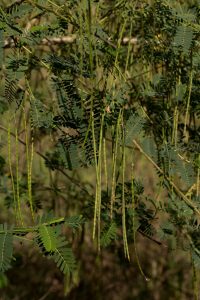
Sesbania sesban.Photo: Bart Wursten. Source: Flora of Zimbabwe.
Sesbania sesban is flowering. On the Tree Day here there was a request to see this plant known as River Bean, sorry we did not see it together. This woody annual is full of character, it came to the garden in soil brought from the shores of the dam. It shares the river bed with Salix mucronata which bears flowers at almost any time of the year. As a garden plant Sesbania sesban is disappointing because the leaves go to sleep when the maroon speckled, yellow flowers open. Flowering is from two hours before sunset, this routine suggests that it is moth pollinated. We should see what visits the blooms as long as they are not put off by mosquito repellent. Sesbania sesban has a place in the plant collector’s garden because it demonstrates the phenomena of movement. Another species of Sesbania with orange flowers is obtainable from nurserymen, there were some planted in Cecil Square along Third Street. Uapaca kirkiana and U. nitida are at an interesting stage of their lives now. The flowers on the male and female trees were overlooked when they were in bud on February 18th. A few days ago the fruit bearing Uapaca kirkiana near the house was observed and seen to have bisexual flowers. Is this usual? Twin and triplet fruits are forming on one stalk. Samples have been preserved in cane spirit and look very pretty at the moment. This discovery sent my companion and I on a Mahobohobo ride to look for more trees bearing bisexual flowers. We were too late, all the stamens had dried up and fruits were quite far advanced. Rapid desiccation due to high temperatures and no rain have made the self sown seedlings under the Uapaca nitida wither away. Some were transplanted in time to save them for the garden. Their upright habit, glossy leaves and scented flowers make these trees worthy of cultivation. Not far away just over the boundary on Chipstow Farm we came across a curious sight. It was a small leaved Uapaca, yes, nitida again, with a Lannea discolor growing within the socket of a broken limb. Several weeks ago, it was actually January 12th – 19th a Boomslang hatchling spent four days on a small solitary Acacia gerrardii near the haystacks. We watched closely, the only food seemed to be ants and flies. It did not stay in the tree overnight and we have not seen it since. It has not been slaughtered, the camouflage was excellent. A photograph by R.Bannister in a book about South African Reptiles shows exactly what was seen on the Acacia gerrardii. When Monotes engleri in the garden was in bloom a pair of striped Cuckoos were busy amongst the foliage near the top of the tree, it was not possible to see what they were doing. The first sighting of a Spotted Creeper working its way up the trunk of a Munondo tree was noted at Tinto recently.
Soon the shrubby Vernonias will be flowering. These belong to the family ASTERACEAE (ex COMPOSITAE). Their small flowers are massed in large off white or white and mauve heads, these are conspicuous and easily found in Winter time. The tall bright blue herbaceous cornflower Vernonia decorates the roadsides now, seeds often find their way into gardens and they deserve a place there because they flower in between seasons. On the kopjes Vernonia exsertiflora is in bud, this species has narrow leaves which are pale grey underneath. We were acquainted with Vernonia exsertiflora on kopjes at Nkodzwi (Duffield’s farm) years ago, it was V. kreismannii in those days. Next month the contribution will feature 1) Tinnea rhodesiana 2)Wood collections 3) Wood collecting and the importance of 4) Madullary Rays.
-Dickie Graves .
ATALANTA FARM – ARCTURUS
Although the road sign had been removed a nice crowd assembled at Atlanta Farm, a gathering which included several local farmers and Nick Webb, on assignment from the BBC and H. Oliewagen a visitor from South Africa. We have 79 ticks on our tree list, but were only able to study a small proportion of them today. The area chosen was on the edge of David Stobart’s dam which, although short on waterfowl, accommodates a pair of Fish Eagles and an Osprey, the latter differing from the former not only in colour and size but by the fact that it holds its prey fore-and aft to the line of flight. Fish Eagles hold theirs crossways. Our short morning peregrination led us to a series of ant hills and ended up on a stony ridge. The contrast in vegetation types between these to adjacent areas was quite remarkable. Another striking feature was the immense size of some of the trees. It is unusual, for instance, to see a Parinari curatellifolia so tall that it was not easy to see the fruit on the branches which were all right at the top of a thick, fat trunk, and an equally impressive
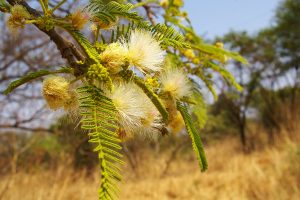
Albizia amara. Photo: Meg Coates Palgrave. Source: Flora of Zimbabwe
Albizia amara with a Ficus thonningii getting its act together in the cleft where the main trunk branched. Kim led us this day and kept us intrigued not only by his knowledge of trees but by offering us fascinating glimpses of his life style. If nothing else sticks in our minds we shall surely remember the interpretation to be put upon anyone with a red stain on their lips or gums (from chewing the roots of Diospyros lycioides) or a yellow stain (from chewing Euclea divinorum). One of the questions at the quiz that Dickie Graves had prepared for our January outing concerned the name of the greenery on Wild Asparagus. We came upon Asparagus laricinos (family LILIACEAE) and Kim, who was one of the few who knew the answer explained that they were not leaves. Although they carry out the photosynthesising function of a true leaf they lack veins and stomata, they are, in fact, modified stems, and they are called Cladodes. Next time you come across one of these unusual plants have a close look – the true leaf is no more than an insignificant scale like growth at the base of the spine. Next time you do a crossword puzzle look out for this unusual word.
After lunch some of us went to look at a most unusual grove of Dalbergia melanoxylon, unusual from the point of view of size and quantity. Nearby, and already shedding its leaves ready for winter, was Commiphora mossambicensis and many heavily fruiting Julbernardia globiflora each with a halo of chocolate brown pods. Thank you, David and Gillian Stobart, for giving us the run of your interesting and attractive farm.
E.R.R.H.
TREE NOTES FROM MUTARE
Well, when one goes on combined birding and treeing operations, it becomes rather confusing. Birding requires one to look into the tree, while treeing it is essential to look at the tree. So one develops double vision. If one is in a forest, one cannot just look up a tree. One has to hunt it down with choppers, helicopters or any device one can imagine. So come to Mutare it becomes rather exciting.
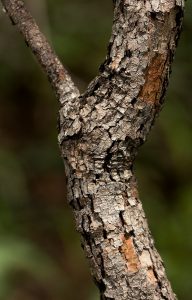
Combretum psidioides.Photo: Bart Wursten. Source: Flora of Zimbabwe.
The John Meikle Estate near Odzi is a natural haven of beauty. One could imagine travelling to a fairy castle, with lowering rocky slopes and steep drops fresh mountain air, streams strewn about with wild flowers, ferns, mosses, tree ferns, Strelitzia nicolai, Podocarpus latifolius abounding. The very well kept roads are shared with natural rock. Closer to home here, trees can actually strike one’s attention as did a Combretum psidioides with its very sticky glutinous bright red pods. The fruit was covered with a gold dust, just at the stage before drying. They grey-green leaves were slightly lobed at the base and had hair like tips. The branchlets were also felted with grey hairs. This tree was so easily identifiable it was impossible to miss. However, it was in a water soaked vlei, but it is suited to dry areas, mixed woodland and Kalahari sand. Perhaps it is the sandy soil and good drainage which makes it possible to it to survive there in Thomson’s Vlei. It does not appear to be common here. Other Combretums occurring here are C. zeyheri, C. paniculatum, C. molle, C. hereoense, C. eythrophyllum. the easiest way of distinguishing between them all is by comparison of the pods before and after the drying stage.
Gail Henning
MUKUVISI WOODLAND NOTES
As we go east from the quarries we enter the main plateau of the Woodland, here again initially see extensive modification by man in the form of extensive shallow excavations, which we can date as post 1946 because clearly a bulldozer was used. I suspect some enterprising municipal official designed an extension to the rubbish tips. Fortuitously he did not succeed. In the midst of the excavation grows one Erythrina lysistemon, delightful in flower, it always makes a good talking point when we have overseas tourists on a walk. Just north of these excavations we come to the start of the groves of Muhacha, Parinari curatellifolia. I have heard experts argue, but I am satisfied they need to keep their feet wet, and in our environment I guess they grow over hollows in the underlying granite which collect water. It was this Parinari woodland which helped us to win the High Court case. Evidence was adduced that ours was the only good stand of this type on public land on the Highveld. Over the last ten years good management has improved both the muhacha canopy and the species composition of both under storey and the few emergents. There is no room for complacency however, experience dictates that a mere few weeks of poor management can undo years of good. We can measure eland damage to the under storey; what has me baffled is an apparent higher than usual mortality of middle aged Parinari, it may be merely a manifestation of competition amongst individuals. After all, if my postulation about pools in the granite is correct, then there is going to be strong competition. On the other hand we must not forget that lots and lots of boreholes are being commissioned in the catchment area, this might be having an effect on overall water tables. It is something we must watch. One of my pet schemes is to tap a water furrow into the Makabusi River upstream of the woodland and run it into the plateau game area. When we first brought in our little eland community they took special delight in Rhus longipes. I suspect it might have been new to them. Anyway, it was like throwing candy to an eland. For a while we thought we would say goodbye to this species, however, like all good children, after a while they got a bit fed up, and now once again R. longipes is alive and well in the game area. Of concern however is the welfare of the Violet Tree regeneration (Securidaca longipedunculata), for a while we were all thrilled at the way this plant pulled itself back from the edge of extirpation. I am a bit worried now. Has anyone seen the youngsters lately? Ten years ago, in the north east sector of the game area I classified the co-dominants as Parinari/Brachystegia, now I might be inclined to drop out the latter, the reason fire control, musasa is not only tolerant of fire, it is stimulated to growth by fire, so while the Parinari and other species have gone ahead, Brachystegia has lagged. And like on the streets, so in the bush, if you stand still you get left behind in the rush. Two species, pioneers both, have been prominent amongst those who have rushed ahead since 1981. Both at that time were ‘rare’ here. Terminalia sericea and Dichrostachys cinerea both are now frequent and are helping to make the present stages of succession so dynamic.
-George Hall.
POTENTIAL FOOD CROPS OF AFRICA
The National Food Council of the USA in a project to record all potential root, grain, legume, vegetable, fruit and nut plants which are used as foods in Africa. Rob Burrett of St George’s College, has undertaken to stimulate interest in this project and would be happy to hear from members who would like to help in any way.
ROOTNOTE JESSE I have been asked to write a short note on jesse vegetation. Jesse is a Shona word and as there are not silent letters in Shona the “e” on the end should be pronounced. As far as I can gather it is a loose term for thick bush but it usually associated with thick bush in the Zambezi Valley. Tom replaces the term with dry layered deciduous forest – a more precise term. He is therefore referring to areas where there are usually two layers of vegetation – a dense shrub layer with a canopy of taller trees above them. In some cases the taller trees have been cleared and then this layer is poorly developed. Species include Xylia, Combretum prunioides, Kirkia acuminata, Schrebera trichoclada, Commiphora caerulea and C. karibensis. The under storey contains many shrubs that may form an impenetrable barrier. Amongst these are Combretum celastroides, C. alaeagnoides, Acacia ataxacantha and Meiostemon tetrandrus. Usually this vegetation grows on well drained sand that is relatively deep and well drained. Sometimes the sand is wind derived (Aeolian sands) as in the sands south of Mana Pools. Although this vegetation type often has a distinct structure the actual species vary quite considerably with some species being fairly common in patches. This may reflect different depths of the underlying sediment. Elephant and rhino frequent the jesse. Around Mana Pools the special Crested Guinea Fowl may be found scratching amongst the undergrowth.
-Kim Damstra.
A CANOE TRIP (continued)
Now there was time to start admiring the great trees of the riverine environment and we learnt to recognise the dominant species along the bank enlightened by Titch. Magnificent specimens of Natal Mahogany, Trichilia emetica whose dense dark green leafy foliage provided wonderful shade when we stopped for lunch. Acacia albida the apple ring acacias, recently reclassified and no longer an Acacia, was just coming into leaf in autumn, all other acacias have new leaves in the spring. It is a vital tree on the flood plains as it sustains many species of game in the dry periods and elephants have a real passion for the pods which are rich in protein and vitamins. Many trees show evidence of scarring from elephant tusks. This year the region has had record rains which have caused flooding on the plain and for the first time in years young albidas have been found germinating, we hope they survive as many large trees have fallen due to the erosion of the bank and the wash of the river. Trees that have fallen sometimes keep on growing and provide a sheltered place for grasses which survive in the winter. Acacia robusta and Acacia tortilis also thrive. Lonchocarpus capassa, the rain tree, occurs in large numbers along the river banks, it was in full pod and easy to recognise as we paddled along. Ficus bussei , the Zambezi fig, stands out majestically. Kigelia africana the sausage tree is present in large numbers. The fruit is a greyish brown and very heavy weighing up to 10 kg. which contains a fibrous pulp in which are embedded many seeds. Extractions of the fruit have been used to cure skin conditions, including cancer. In local folk lore they have properties for increasing growth of sex organs and increasing lactation. The flowers are pollinated by bats and are eaten by game when they fall to the ground. The wood is rather soft but tough and used to make dugout canoes. We saw several of these used by the Zambians living on the opposite bank.
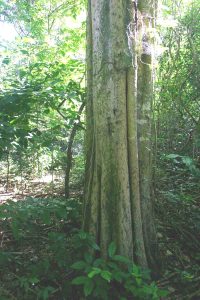
Balanites maughamii. Photo: Bart Wursten. Source: Flora of Zimbabwe.
Balanites maughamii, Y thorned torch wood is much in evidence, the seeds yield an oil equal to the best olive oil which burns with a bright flame. The dry kernels are sometimes used as torches. The False baobab, tick tree or African star chestnut known as Sterculia africana stands out with its smooth peeling bark which reveals a marbled effect. The African mangosteen Garcinia livingstonei also much in evidence distinguished by stiff rigid branches of glossy dark green leaves sticking out at acute angles. Lunch was served in deep cool shade, a most welcome interlude in which we imbibed G and T or beer and were served cold chicken and fresh salads and cheese and fruit by Anthony Titch and Larry Norton who was travelling with us in Anthony’s canoe. Larry is pursuing a career as a wild life artist and is a most likeable fellow. He is rapidly building himself a well justified reputation and we saw a sample of his work which was most impressive. It was good to be able to relax after the first few tense moments of maneuvering our canoes in line behind our guide and then successfully turning into the bank then clambering out into black sticky Zambezi mud which was to be a feature in our lives for the next few days. Bobby slipped into the river as he stepped out much to the amusement of the rest of the party. Hippo thrive in the Zambezi and we met a pod of 20 to 30 at regular intervals and we were pretty nervous of this lot. However out guides were very good in getting us round them but some self inflicted bad moments were to follow later. They are remarkable animals and watch the canoes go by with their eyes and ears just above the surface every now and then blowing and snorting at is intrusion into their own particular part of paradise. We pass Kanyemba island and on past where the Kafue river joins the Zambezi heading to our first night stop, a sandy island with the unlikely name of Co-Co-na-Marara a sort of Shona Connemara I suppose! – to be continued.
Ann and Jim Sinclair
DICK HICKS CHAIRMAN


